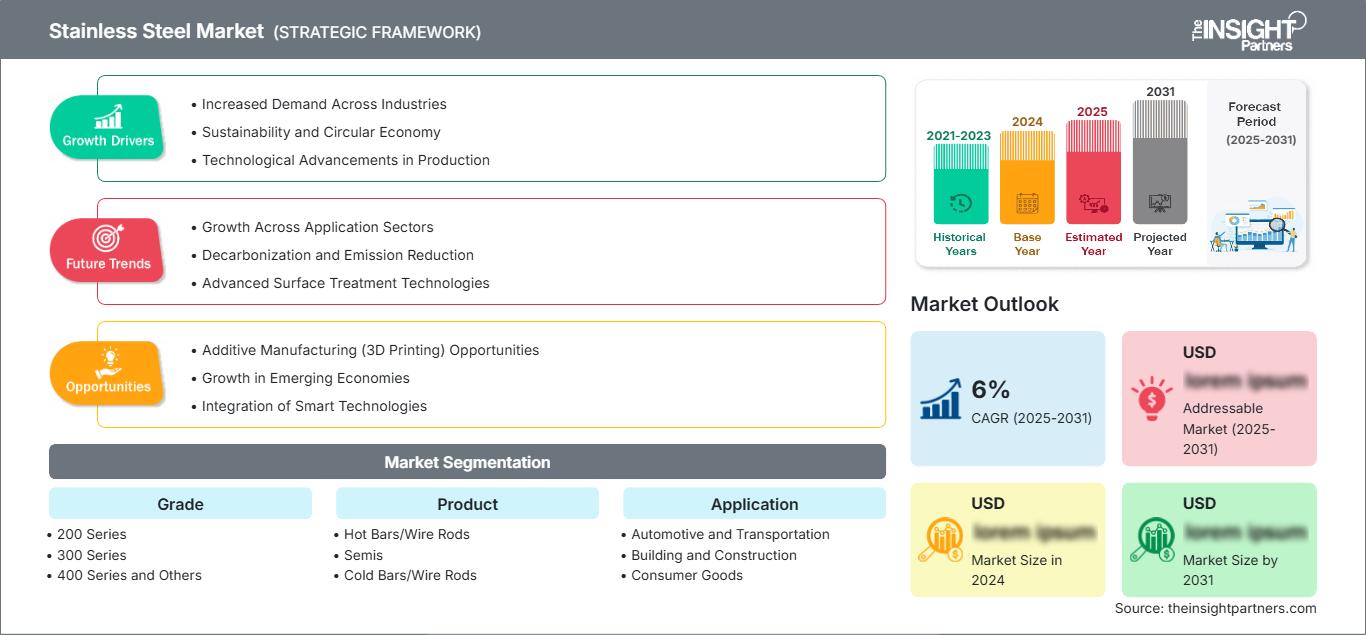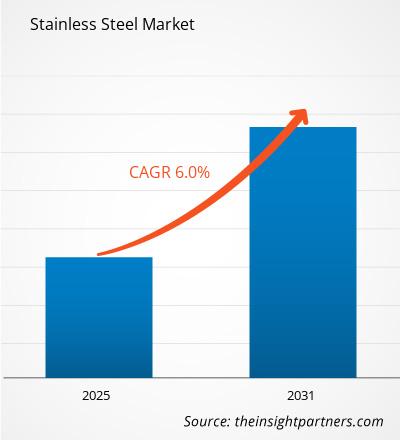预计到2031年,不锈钢市场规模将达到1734.8亿美元。预计2025年至2031年期间,该市场将以2.7%的复合年增长率增长。
本报告按钢种(200系、300系、400系及其他)和产品(热轧棒材/线材、半成品、冷轧棒材/线材、热轧卷材、热轧板材和冷轧扁钢)进行细分。报告还基于应用领域(汽车及交通运输、建筑及施工、消费品、重工业、电机及其他)进行分析。全球分析进一步细分至区域和主要国家。报告涵盖所有关键细分市场的全球、区域和国家层面的市场规模和预测。报告以美元为单位提供上述分析和细分市场的价值。报告提供主要市场参与者的市场地位关键统计数据,并分析市场趋势和机遇。
报告目的
The Insight Partners发布的《不锈钢市场报告》旨在描述当前市场格局和未来增长趋势,以及主要驱动因素、挑战和机遇。该报告将为各类商业利益相关者提供参考,例如:
- 技术提供商/制造商:了解不断变化的市场动态和潜在的增长机会,从而能够做出明智的战略决策。
- 投资者:对市场增长率、市场财务预测以及整个价值链中存在的机会进行全面的趋势分析。
- 监管机构:监管市场政策和执法活动,旨在最大限度地减少滥用行为,维护投资者信任和信心,维护市场的诚信和稳定。
不锈钢市场细分等级
- 200系列
- 300系列
- 400系列及其他
产品
- 热棒/线材
- 半
- 冷棒/线材
- 热线圈
- 热板、片材和冷轧扁钢
应用
- 汽车与运输
- 建筑施工
- 消费品
- 重工业
- 电机及其他
地理
- 北美
- 欧洲
- 亚太
- 南美洲和中美洲
- 中东和非洲
您可以免费获得任何报告的定制服务,包括本报告的部分内容、国家/地区层面的分析、Excel 数据包,以及面向初创企业和高校的优惠折扣。
不锈钢市场:战略洞察

-
获取本报告的主要市场趋势。这份免费样品将包含数据分析,内容涵盖市场趋势、估算和预测等。
不锈钢市场增长驱动因素
- 各行业需求增长:建筑、汽车、消费品等各终端用户行业对不锈钢的需求不断增长,已成为不锈钢市场的重要驱动力。其中,建筑行业受益于城市化和基础设施建设,呈现出良好的增长态势,对用于结构、屋顶和外墙的不锈钢需求日益增长。同样,汽车行业也因不锈钢的耐久性和抗腐蚀性而受益,从而提升了车辆的耐用性和性能。
- 可持续性和循环经济:各行各业越来越重视可持续发展规范,制造商也更加积极地推行环保实践。不锈钢具有可重复利用的特性,因此也是全球减少浪费议程的重要组成部分,并连接着循环经济价值链。随着排放和材料使用方面监管标准的日益严格,各行业将继续转向不锈钢等可持续替代品,从而增加不锈钢的消费量。
- 生产技术进步:熔炼和精炼工艺的改进以及新型制造技术的出现,提高了不锈钢生产的效率和质量。例如,电弧炉(EAF)技术由于能耗和排放量的降低,使钢铁生产方式更加可持续。这降低了生产成本,提高了产品质量,从而提升了产品对终端用户的价值。
不锈钢市场未来趋势
- 应用领域增长迅速:不锈钢在工业领域的应用呈爆炸式增长。这主要归功于其前文所述的优异性能,例如耐腐蚀性、强度和美观性。这些优势使其在建筑、汽车、食品加工和消费品等行业得到广泛应用,在这些行业中,耐用性、安全性和美观性都至关重要。
- 脱碳与减排:随着生产过程中脱碳和减排的推进,钢铁行业的碳减排压力日益增大。企业正在探索新的减排途径,例如利用可再生能源和安装碳捕获技术,以降低不锈钢生产过程中的排放。因此,这不仅是监管要求,也是满足消费者对环保产品的期望。
- 先进表面处理技术:电抛光和其他先进表面处理技术持续受到关注,显著提升了不锈钢产品的性能和美观度。优异的耐腐蚀性、表面光洁度和美观性使不锈钢成为食品加工、制药和高端消费品等行业的理想选择。这一趋势体现了行业对品质和性能的不懈追求。
不锈钢市场机遇
- 增材制造(3D打印)机遇:增材制造(3D打印)技术的引入为不锈钢行业带来了巨大的发展机遇。与传统的制造工艺相比,该技术能够制造出独特的几何形状和复杂的定制部件,从而显著提升了制造效率。随着各行业寻求更高效、更灵活的生产模式,不锈钢的应用前景和市场潜力也日益凸显。
- 新兴经济体的增长:新兴经济体正快速迈向工业化和城市化,为不锈钢生产商创造了绝佳的机遇。随着这些市场的增长和发展,消费模式也将相应转变,建筑、汽车和消费品行业对不锈钢的需求将大幅增长。目前已在这些地区设立分支机构的公司有望从这一繁荣中获益,并占据可观的市场份额。
- 智能技术集成:物联网和人工智能等智能技术可集成到不锈钢生产流程中。这些技术的应用将改善运营并提升产品质量。制造商将利用数据分析、减少浪费和改进供应链管理来优化生产线。这种工艺技术的改进将通过缩短交货周期,提高生产效率并增强对市场需求和消费者偏好的响应能力。
不锈钢市场区域洞察
The Insight Partners 的分析师对预测期内影响不锈钢市场的区域趋势和因素进行了详尽的阐述。本节还探讨了北美、欧洲、亚太、中东和非洲以及南美和中美洲等地区的不锈钢市场细分和地域分布。
不锈钢市场报告范围
| 报告属性 | 细节 |
|---|---|
| 2024年市场规模 | XX亿美元 |
| 到2031年市场规模 | 1734.8亿美元 |
| 全球复合年增长率(2025-2031年) | 2.7% |
| 史料 | 2021-2023 |
| 预测期 | 2025-2031 |
| 涵盖的领域 |
按年级
|
| 覆盖地区和国家 |
北美
|
| 市场领导者和主要公司简介 |
|
不锈钢市场参与者密度:了解其对业务动态的影响
受终端用户需求不断增长的推动,不锈钢市场正快速发展。终端用户需求增长的驱动因素包括消费者偏好的转变、技术的进步以及消费者对产品优势的认知度提高。随着需求的增长,企业不断拓展产品线、创新以满足消费者需求并把握新兴趋势,这些都进一步推动了市场增长。

- 获取不锈钢市场主要参与者概览
主要卖点
- 全面覆盖:该报告全面分析了不锈钢市场的产品、服务、类型和最终用户,提供了一个全面的市场概况。
- 专家分析:该报告是根据行业专家和分析师的深入理解编制的。
- 最新信息:该报告涵盖了最新的信息和数据趋势,确保了其与业务的相关性。
- 定制选项:本报告可根据客户的具体需求进行定制,并能恰当地适应业务战略。
因此,这份不锈钢市场研究报告有助于深入了解和解读行业现状及增长前景。尽管其中可能存在一些合理的担忧,但总体而言,该报告的优势远大于劣势。
- 历史分析(2 年)、基准年、预测(7 年)及复合年增长率
- PEST和SWOT分析
- 市场规模、价值/数量 - 全球、区域、国家
- 行业和竞争格局
- Excel 数据集
近期报告
客户评价
购买理由
- 明智的决策
- 了解市场动态
- 竞争分析
- 客户洞察
- 市场预测
- 风险规避
- 战略规划
- 投资论证
- 识别新兴市场
- 优化营销策略
- 提升运营效率
- 顺应监管趋势






















 获取免费样品 - 不锈钢市场
获取免费样品 - 不锈钢市场